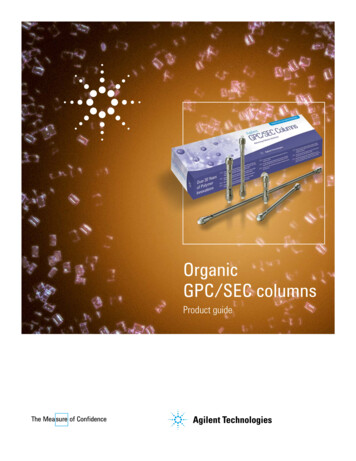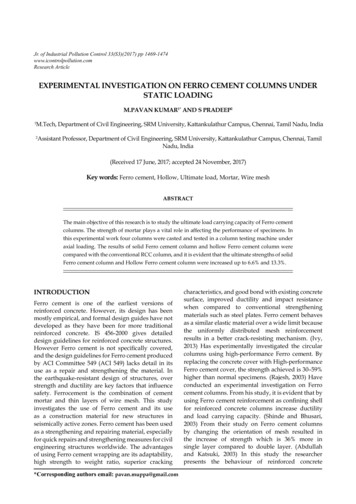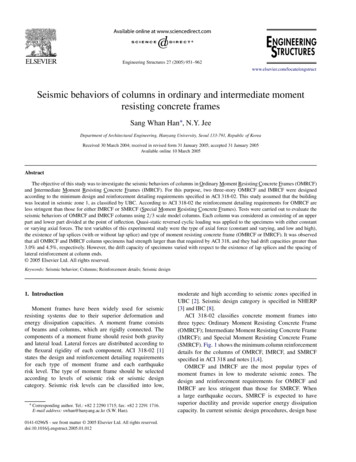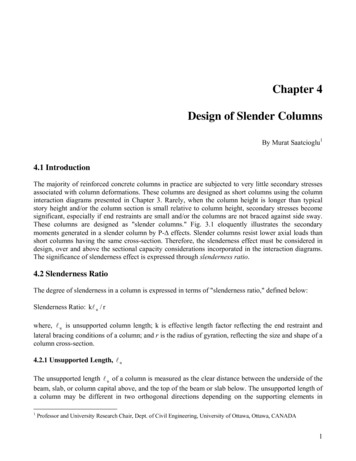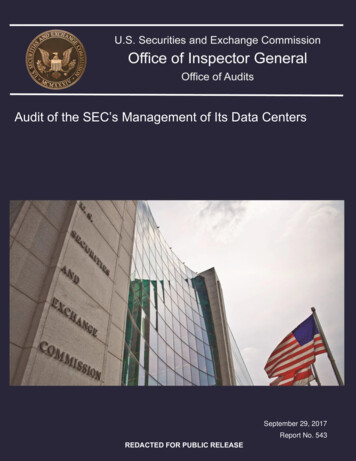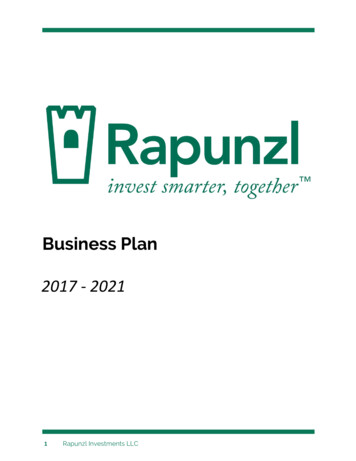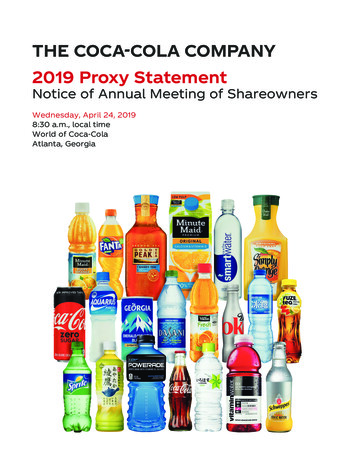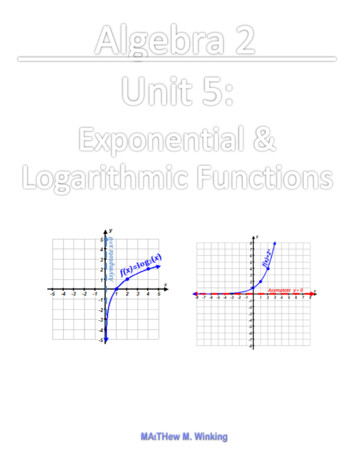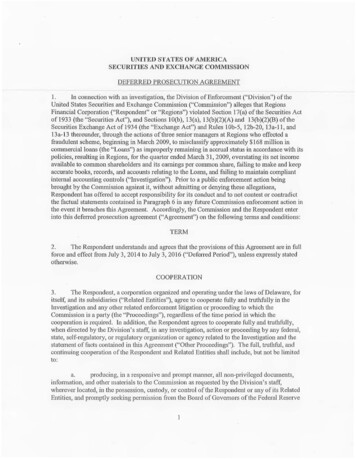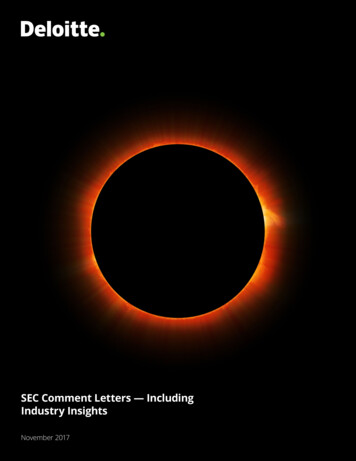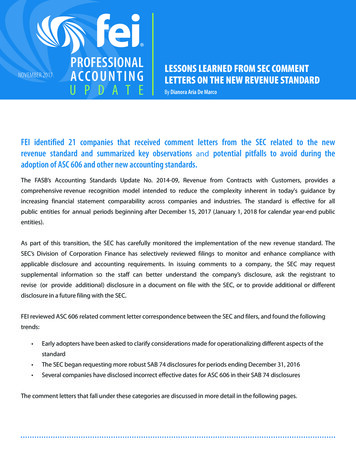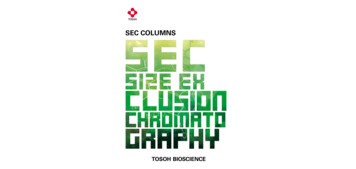
Transcription
PRINCIPLES OF CHROMATOGRAPHYSEC COLUMNSThe analysis, isolation, and purifi c ation of biomolecules can beaccomplished by a number of chromatographic modes. Each modeis based on specific physical, chemical, or biological interactionsbetween the sample biomolecule and packing material.Tosoh Bioscience offers a comprehensive line of TSKgel and TOYOPEARLmedia and pre-packed TSKgel columns for all common modes of liquidchromatography.The various modes of chromato graphy involve separations that arebased on specific features of the target or sample, like size, charge,hydropho bi city, function or specific content of the molecule.To find out more about general principles of liquid chromatographyand on how each of them works, visit us on our YouTube channelhttps://youtu.be/E3z1wIImvHITOSOH BIOSCIENCEIm Leuschnerpark 4 64347 Griesheim, GermanyTel: 49 6155-7043700 Fax: 49 6155-8357900info.tbg@tosoh.com www.tosohbioscience.deB18L18ASIZE EXCLUSION CHROMATOGRAPHY
TOSOH BIOSCIENCEABOUT US2TOSOH BIOSCIENCE LLC3604 HORIZON DRIVE,SUITE 100KING OF PRUSSIA, PA 19406, USA3TOSOH CORPORATION3-8-2 SHIBA, MINATO-KUTOKYO 105-8623JAPANT 49 (0) 6155 70437 00F 49 (0) 6155 83579 00INFO.TBG@TOSOH.COMWWW.TOSOHBIOSCIENCE.DET 1 484 805 1219F 1 610 272 CIENCE.COMT 81 3 5427 5118F 81 3 5427 5198INFO@TOSOH.CO.JPWWW.TOSOHBIOSCIENCE.COMSAMPLE LOAD1234SECSECOPTIMIZING SEC1TOSOH BIOSCIENCE GMBHIM LEUSCHNERPARK 464347 GRIESHEIMGERMANYWITH A GLOBAL PERSPECTIVE.Tosoh Bioscience is a leading manufacturer in the field of liquidchromatography. The portfolio of over 500 specialty products encompasses instruments for size exclusion/gel permeation chromatography and a comprehensive line of media and prepacked (U)HPLCcolumns for all common modes of liquid chromatography. Over thelast 40 years, TSKgel SW columns have become the worldwide industry standard for size exclusion chromatography of biomolecules.ANALYSISAs SEC is a partition chromatography, sample load on thecolumn is limited. High sample loads distort peak shapes andcause an overall decrease in efficiency due to column overload. Optimal sample load highly depends on the sampleproperties (sample matrix) and the separation task. Foranalytical columns, sample concentrations of 1-20 mg/ml arerecommended. Proteins can be loaded at higher concentrations and higher total loads than synthetic macromolecules.For preparative purposes for example, 100 mg of BSA canbe loaded on two 21.5 mm ID x 60 cm L TSKgel G3000SWcolumns, but only 20 mg of PEG 7500.Sample volume depends very much on the type of column.On TSKgel SuperSW columns for example, a 5 µL injectionvolume ensures optimal results. Standard injection volumesfor 7.5 and 7.8 mm ID columns are 20-100 µl, whereas forpreparative purposes on 21.5 mm ID columns, injectionvolumes may be raised up to 2 ml.MOBILE PHASEProper selection of the mobile phase is necessary to maximizemolecular sieving mechanism and to minimize secondaryeffects such as ionic and hydrophobic interaction betweenthe sample and the column packing material. For each samplethere will be an optimum buffer type and concentration thatresults in the highest resolution and recovery.FIGURE 245TOSOH ASIA PTE. LTD.63 MARKET STREET #10-03BANK OF SINGAPORE CENTRESINGAPORE 048942, SINGAPORET 65 6226 5106F 65 6226 5215INFO.TSAS@TOSOH.COMWWW.TOSOHASIA.COMTOSOH HISTORY1935 Founding of Toyo Soda Manufacturing Co., Ltd.INFLUENCE OF MOBILE PHASE200200Intensity (mAu)4TOSOH BIOSCIENCE SHANGHAI CO. LTD.ROOM 301, PLAZA B,NO. 1289 YI SHAN ROADXU HUI DISTRICTSHANGHAI, 200233, CHINAT 86 21 3461 0856F 86 21 3461 SCIENCE.COMIntensity (mAu)Tosoh manufacturing sites in Japan provide products to the salesand support subsidiaries in the U.S. and Europe, ensuring full global coverage. Our technical specialists in the European Headquarters provide assistance in developing HPLC applications or purification methods, in up-scaling, or packing process columns. Weoffer chromatographic workshops, on-site training, and are thesole sponsor of the HIC/DSP Bioseparation Conference series.5150100150100505000For TSKgel SW columns mobile phases a buffer concentration between 0.1 M and 0.5 M is recommended. Underlow ionic strength ( 0.1 M), ionic interactions between thesample molecules and the silica surface may occur. Under conditions of high ionic strength ( 1.0 M), hydrophobicinteractions are more likely to occur. A neutral salt, suchas sodium sulphate may be added to the buffer to increasebuffer ionic strength. Also the ionic species of the buffer hasan effect on the separation. As a good starting point, a 0.1M sodium phosphate buffer together with 0.1 M sodiumsulphate has proved to be of value.As the polymeric TSKgel PW and Alpha-type resins carryless residual charged groups on the surface than silicagels, salt concentration of the mobile phase can be lower.Non-ionic, non-polar compounds such as polyethyleneglycols can simply be analyzed with distilled water. For ionicpolymeric compounds, a neutral salt such as sodium nitrateis added to the aqueous eluent. Generally, a concentrationof 0.1 M to 0.2 M is sufficient to overcome undesirable ionicinteractions.If hydrophobic interaction occurs between the sample andthe column matrix, a water soluble organic solvent can beadded to the mobile phase. The addition of acetonitrile,acetone, ethanol or methanol up to a concentration of 20%may also prevent columns from fouling by suppressinginteraction of hydrophobic impurities of the sample. Anexample is shown in Figure 24 with the analysis of a pegylated protein on a TSKgel G3000SWXL column. As pegylatedproducts are more hydrophobic, they tend to interact withthe column matrix. Over time the pegylated product can foulthe column, which is indicated by shifts of retention timeand decreasing separation performance. By adding 10% ofethanol to the elution buffer, this problem is overcome and nodifferences in performance at the first and the 150th injectionare observed (courtesy of J.J. Ratto et al. Amgen Inc., 1996).COLUMN PROTECTION1936 Operation of Nanyo Manufacturing Complex begins1971 First TSKgel GPC column developed1974 HPLC Column Plant starts production1977 First silica based TSKgel SW column for protein analysis1979 Tosoh develops TOYOPEARL media for preparative chromatography1987 Introduction of TSKgel G3000SWXL Column, the gold standard for aggregation analysis1993 First TSKgel Semi Micro GPC columns increase sensitivity, save time and solvent1995 Tosoh Nanyo Gel Factory receives ISO 90011997 Reaching the milestone of 10 000 TSKgel G3000SWXL columns2008 TSKgel STAT ion exchange columns introduced2013 High capacity TOYOPEARL Protein A resin for antibody purification introduced2014 TOSOH Bioscience GmbH celebrates its 25th anniversary2015 TSKgel UP-SW3000 UHP-SEC columns for easy transfer of HPLC methods to UHPLC2016 Protein A column for fast mAb titer determination2017 Construction of a new R & D laboratory center announced78910 1112Elution time (min)1378910 1112Elution time (min)A: No ethanol in mobile phaseB: 10% ethanol in mobile phaseColumn:TSKgel G3000SWXL, 5 µm, 7.8 mm ID x 30 cm LMobile phase: 0.1 M sodium phosphate, pH 6.9, 0.5 M NaCl,Flow rate:0.7 mL/minDetection:UV @ 220 nminitial injection;after 150 injectionsSample:10 mL PEG r-HuMGDF13To protect the column and increase its lifetime, the use ofa guard column is strongly recommended. Sample purity,sample load and the composition of the mobile phase havean influence on column lifetime. For information on TSKgelSEC columns for GPC analysis of organic polymers pleaserefer to the TSKgel GPC column brochure.
PRINCIPLES OF CHROMATOGRAPHYSEC COLUMNSThe analysis, isolation, and purifi c ation of biomolecules can beaccomplished by a number of chromatographic modes. Each modeis based on specific physical, chemical, or biological interactionsbetween the sample biomolecule and packing material.Tosoh Bioscience offers a comprehensive line of TSKgel and TOYOPEARLmedia and pre-packed TSKgel columns for all common modes of liquidchromatography.The various modes of chromato graphy involve separations that arebased on specific features of the target or sample, like size, charge,hydropho bi city, function or specific content of the molecule.To find out more about general principles of liquid chromatographyand on how each of them works, visit us on our YouTube channelhttps://youtu.be/E3z1wIImvHITOSOH BIOSCIENCEIm Leuschnerpark 4 64347 Griesheim, GermanyTel: 49 6155-7043700 Fax: 49 6155-8357900info.tbg@tosoh.com www.tosohbioscience.deB18L18ASIZE EXCLUSION CHROMATOGRAPHY
TOSOH BIOSCIENCEABOUT US2TOSOH BIOSCIENCE LLC3604 HORIZON DRIVE,SUITE 100KING OF PRUSSIA, PA 19406, USA3TOSOH CORPORATION3-8-2 SHIBA, MINATO-KUTOKYO 105-8623JAPANT 49 (0) 6155 70437 00F 49 (0) 6155 83579 00INFO.TBG@TOSOH.COMWWW.TOSOHBIOSCIENCE.DET 1 484 805 1219F 1 610 272 CIENCE.COMT 81 3 5427 5118F 81 3 5427 5198INFO@TOSOH.CO.JPWWW.TOSOHBIOSCIENCE.COMSAMPLE LOAD1234SECSECOPTIMIZING SEC1TOSOH BIOSCIENCE GMBHIM LEUSCHNERPARK 464347 GRIESHEIMGERMANYWITH A GLOBAL PERSPECTIVE.Tosoh Bioscience is a leading manufacturer in the field of liquidchromatography. The portfolio of over 500 specialty products encompasses instruments for size exclusion/gel permeation chromatography and a comprehensive line of media and prepacked (U)HPLCcolumns for all common modes of liquid chromatography. Over thelast 40 years, TSKgel SW columns have become the worldwide industry standard for size exclusion chromatography of biomolecules.ANALYSISAs SEC is a partition chromatography, sample load on thecolumn is limited. High sample loads distort peak shapes andcause an overall decrease in efficiency due to column overload. Optimal sample load highly depends on the sampleproperties (sample matrix) and the separation task. Foranalytical columns, sample concentrations of 1-20 mg/ml arerecommended. Proteins can be loaded at higher concentrations and higher total loads than synthetic macromolecules.For preparative purposes for example, 100 mg of BSA canbe loaded on two 21.5 mm ID x 60 cm L TSKgel G3000SWcolumns, but only 20 mg of PEG 7500.Sample volume depends very much on the type of column.On TSKgel SuperSW columns for example, a 5 µL injectionvolume ensures optimal results. Standard injection volumesfor 7.5 and 7.8 mm ID columns are 20-100 µl, whereas forpreparative purposes on 21.5 mm ID columns, injectionvolumes may be raised up to 2 ml.MOBILE PHASEProper selection of the mobile phase is necessary to maximizemolecular sieving mechanism and to minimize secondaryeffects such as ionic and hydrophobic interaction betweenthe sample and the column packing material. For each samplethere will be an optimum buffer type and concentration thatresults in the highest resolution and recovery.FIGURE 245TOSOH ASIA PTE. LTD.63 MARKET STREET #10-03BANK OF SINGAPORE CENTRESINGAPORE 048942, SINGAPORET 65 6226 5106F 65 6226 5215INFO.TSAS@TOSOH.COMWWW.TOSOHASIA.COMTOSOH HISTORY1935 Founding of Toyo Soda Manufacturing Co., Ltd.INFLUENCE OF MOBILE PHASE200200Intensity (mAu)4TOSOH BIOSCIENCE SHANGHAI CO. LTD.ROOM 301, PLAZA B,NO. 1289 YI SHAN ROADXU HUI DISTRICTSHANGHAI, 200233, CHINAT 86 21 3461 0856F 86 21 3461 SCIENCE.COMIntensity (mAu)Tosoh manufacturing sites in Japan provide products to the salesand support subsidiaries in the U.S. and Europe, ensuring full global coverage. Our technical specialists in the European Headquarters provide assistance in developing HPLC applications or purification methods, in up-scaling, or packing process columns. Weoffer chromatographic workshops, on-site training, and are thesole sponsor of the HIC/DSP Bioseparation Conference series.5150100150100505000For TSKgel SW columns mobile phases a buffer concentration between 0.1 M and 0.5 M is recommended. Underlow ionic strength ( 0.1 M), ionic interactions between thesample molecules and the silica surface may occur. Under conditions of high ionic strength ( 1.0 M), hydrophobicinteractions are more likely to occur. A neutral salt, suchas sodium sulphate may be added to the buffer to increasebuffer ionic strength. Also the ionic species of the buffer hasan effect on the separation. As a good starting point, a 0.1M sodium phosphate buffer together with 0.1 M sodiumsulphate has proved to be of value.As the polymeric TSKgel PW and Alpha-type resins carryless residual charged groups on the surface than silicagels, salt concentration of the mobile phase can be lower.Non-ionic, non-polar compounds such as polyethyleneglycols can simply be analyzed with distilled water. For ionicpolymeric compounds, a neutral salt such as sodium nitrateis added to the aqueous eluent. Generally, a concentrationof 0.1 M to 0.2 M is sufficient to overcome undesirable ionicinteractions.If hydrophobic interaction occurs between the sample andthe column matrix, a water soluble organic solvent can beadded to the mobile phase. The addition of acetonitrile,acetone, ethanol or methanol up to a concentration of 20%may also prevent columns from fouling by suppressinginteraction of hydrophobic impurities of the sample. Anexample is shown in Figure 24 with the analysis of a pegylated protein on a TSKgel G3000SWXL column. As pegylatedproducts are more hydrophobic, they tend to interact withthe column matrix. Over time the pegylated product can foulthe column, which is indicated by shifts of retention timeand decreasing separation performance. By adding 10% ofethanol to the elution buffer, this problem is overcome and nodifferences in performance at the first and the 150th injectionare observed (courtesy of J.J. Ratto et al. Amgen Inc., 1996).COLUMN PROTECTION1936 Operation of Nanyo Manufacturing Complex begins1971 First TSKgel GPC column developed1974 HPLC Column Plant starts production1977 First silica based TSKgel SW colu
Proper selection of the mobile phase is necessary to maximize molecular sieving mechanism and to minimize secondary effects such as ionic and hydrophobic interaction between the sample and the column packing material. For each sample there will be an optimum buffer type and concentration that results in the highest resolution and recovery. For TSKgel SW columns mobile phases a buffer concen .
